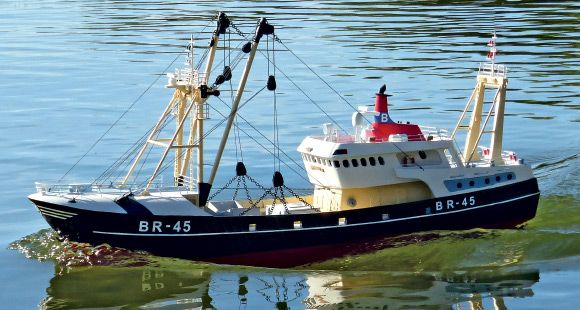Barry Lalonde’s Beam Trawler

The inspiration for this model boat came from the BBC TV programme ‘Fish Town’, a series based on the fishing port of Brixham in Devon. The Beam Trawlers displayed in the series of programmes appealed to me as they were working boats, sitting firmly in the water and had lots of character and also, I had never made a working model boat before.
Researching the subject online, I came across a drawing that caught my eye which seemed to fit the bill as to what I was looking for, and so printed it. This then produced a drawing 11.2cm long by 2.5cm wide and after doing a few calculations, I decided to scale these drawings up by a factor of 7 giving a model of 78.4cm (30.9ins) length by 17.5cm (6.9ins) beam which was a sensible and practical size, plus the width suited the wood purchased from the local DIY store for the princely sum of £15, this being an inexpensive way of producing the hull. This model would be scratch built and I guess it is classed as a stand-off scale model to a scale of approx. 1:55 and the picture shows Dreamcatcher on the water, its name having no special connotations.
Enjoy more Model Boats Magazine reading in the monthly magazine.
Click here to subscribe & save.
Getting started
It was now time to draw a few line drawings for the basic hull and this was done on some wallpaper using the reverse side. Only a side view and a plan view were needed for the intended bread and butter style building method, favoured for my last few models. The individual layers of wood, which are 18mm thick, were marked on the side view and combining these with the plan view gave enough information for the outside lines to be drawn at each plank level. The thickness of the hull was set at 20mm along the sides with extra at the bow, stern and the bottom plank edges to allow for the carving and shaping of these extremely curved areas. The internal lines for the bottom few planks were a bit of a guesstimate, but the discarded pieces were numbered and kept just in case some of them need to be glued back in place later following over-enthusiastic sanding and carving! As it so happened, that did not happen with Dreamcatcher, but it did on a previous model although no harm was done as the exact piece was found and it being a perfect fit was easy to glue back, and you would never know the mishap had taken place.
Read the full article in Model Boats August 2017
For more great articles subscribe to Model Boats today




